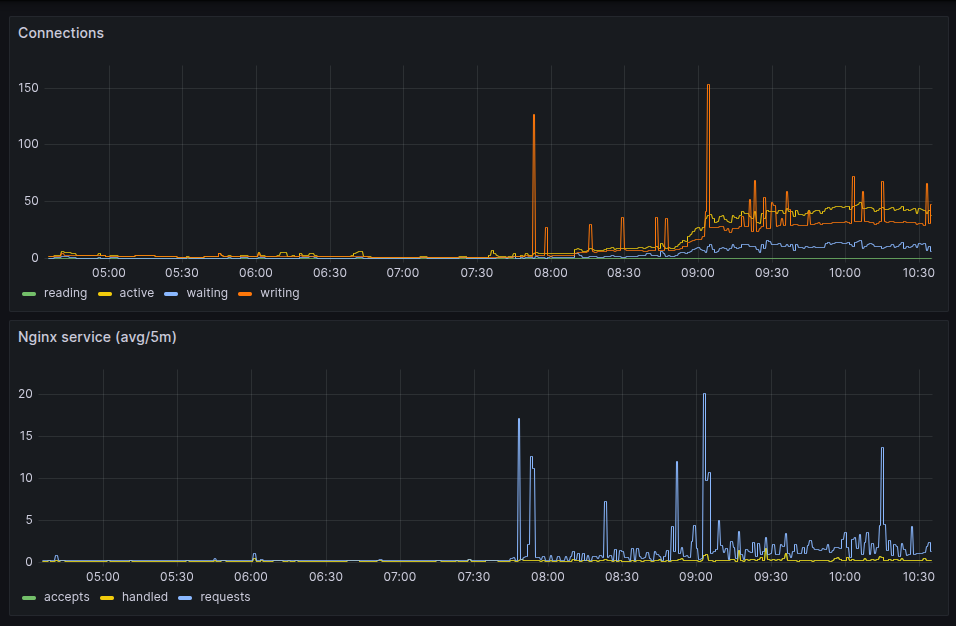
Seguindo o artigo expondo as métricas do nginx pro prometheus, aqui está o resultado olhado no grafana.
Como os valores
server_accepts_total,
server_handled_total e
server_requests_total
são do tipo counter,
eu usei um irate(__variável__[5m])
pra mostrar no gráfico da forma acima.
E como coletei esses dados? Eu já tinha comentado no artigo configurando o grafana alloy pra monitorar VMs que uso o alloy. Então foi adicionando uma entrada extra nele.
[...]
discovery.relabel "metrics_agent" {
targets = array.concat(
[{
__address__ = "localhost:9090",
}],
)
rule {
source_labels = ["__address__"]
target_label = "instance"
}
}
[...]
prometheus.scrape "nginx_metrics" {
targets = discovery.relabel.metrics_agent.output
forward_to = [prometheus.remote_write.prod.receiver]
}
Agora fica mais fácil entender o que acontece com as páginas servidas e se tem realmente alguma lentidão.

Confesso que pra escrever o script pra lers os logs do servidor web, aquele que mostrei em acessos de robôs nos logs web, foi algo próximo do vudu. Tudo porque o formato gerado não é lá muito amigável.
Idem pras máquinas do trabalho. Então hoje eu resolvi dar uma olhada se tinha como escrever esses mesmos logs em json.
E tem.
O primeiro que olhei foi no nginx. E é bem fácil de fazer.
log_format logger-json escape=json '{"source": "nginx", "time": "$time_iso8601", "resp_body_size": $body_bytes_sent, "host": "$http_host", "address": "$remote_addr", "request_length": $request_length, "method": "$request_method", "uri": "$request_uri", "status": $status, "user_agent": "$http_user_agent", "resp_time": $request_time, "upstream_addr": "$upstream_addr"}';
[...]
server {
listen 443 ssl;
server_name api.company.com;
...
access_log /var/log/nginx/access.log logger-json;
...
}
Eu segui a receita desses dois links aqui:
https://www.velebit.ai/blog/nginx-json-logging/
https://nginx.org/en/docs/http/ngx_http_log_module.html#log_format
Pro Apache não tem um módulo que já gera tudo meio mastigado como no nginx. Mas você pode criar o formato do log como quiser.
LogFormat "{ \"time\":\"%{%Y-%m-%d}tT%{%T}t.%{msec_frac}tZ\", \"process\":\"%D\", \"filename\":\"%f\", \"remoteIP\":\"%a\", \"host\":\"%V\", \"request\":\"%U\", \"query\":\"%q\", \"method\":\"%m\", \"status\":\"%>s\", \"userAgent\":\"%{User-agent}i\", \"referer\":\"%{Referer}i\" }" combined
ErrorLogFormat "{ \"time\":\"%{%Y-%m-%d}tT%{%T}t.%{msec_frac}tZ\", \"function\" : \"[%-m:%l]\" , \"process\" : \"[pid %P:tid %T]\" , \"message\" : \"%M\" ,\ \"referer\"\ : \"%{Referer}i\" }"
E esse veio de dica do stack-overflow:
Eu não segui os mesmos parâmetros entre apache e nginx. Por enquanto estou só testando e estar com os campos bem definidos já é o suficiente pra mim.
> tail -1 /var/log/apache2/linux-br-access.log | jq .
{
"time": "2025-08-20T09:38:59.369Z",
"process": "241797",
"filename": "/var/www/linux-br.org/index.php",
"remoteIP": "54.36.149.72",
"host": "linux-br.org",
"request": "/date/2024/03/page/3/",
"query": "",
"method": "GET",
"status": "200",
"userAgent": "Mozilla/5.0 (compatible; AhrefsBot/7.0; +http://ahrefs.com/robot/)",
"referer": "-"
}
Agora ficou fácil de filtrar e pegar só os campos que interessam. E usando "jq".
> tail -1 /var/log/apache2/linux-br-access.log | jq ".userAgent"
"Mozilla/5.0 (compatible; AhrefsBot/7.0; +http://ahrefs.com/robot/)"
> tail -3 /var/log/apache2/linux-br-access.log | jq ".userAgent"
"Mozilla/5.0 (compatible; AhrefsBot/7.0; +http://ahrefs.com/robot/)"
"Mozilla/5.0 (compatible; SemrushBot/7~bl; +http://www.semrush.com/bot.html)"
"Mozilla/5.0 (compatible; AhrefsBot/7.0; +http://ahrefs.com/robot/)"

Esses dias eu peguei um problema no servidor web, nginx. Não nele especificamente. Mas um usuário estava reclamando que estava super lento pra carregar as páginas.
A questão então é como ver como e quanto está o nginx. Infelizmente a versão open source não fornece muita coisa. Só uma versão texto de estatísticas.
Não é grande coisa mas pelo menos já é ALGUMA COISA.
Agora como monitorar isso no Grafana?
A resposta são open metrics. E isso não tem.
Não tinha.
Fiz um programa em Go que converte essas estatísticas em open metrics e expõe na porta 9090 no endpoint /metrics.
Pra ter isso funcionando, é preciso primeiro subir a configuração de estatísticas no nginx.
server {
listen 127.0.0.1:8080;
location /api {
stub_status;
allow 127.0.0.1;
deny all;
}
}
Eu salvei no arquivo statistics.conf e coloquei em /etc/nginx/conf.d.
E bastou um reload pra ter funcionado.
❯ curl localhost:8080/api
Active connections: 2
server accepts handled requests
21 21 322
Reading: 0 Writing: 1 Waiting: 1
Agora é rodar o programa e apontar pra esse endpoint.
❯ ./nginx-openmetrics/nginx-openmetrics --service=http://localhost:8080/api
[2025-08-22T14:11:45] (INFO): 🚚 fetching data from:http://localhost:8080/api
[2025-08-22T14:11:45] (INFO): 🎬 starting service at port:9090
E a porta fica exposta pras métricas serem coletadas pelo prometheus ou grafana alloy. Ou qualquer outro programa que faça scrape de dados no padrão open metrics.
❯ curl localhost:9090/metrics
# HELP active_connections The number of active connections
# TYPE active_connections gauge
active_connections 1
# HELP reading_connections The number of active reading connections
# TYPE reading_connections gauge
reading_connections 0
# HELP server_accepts_total The total number of server accepted connections
# TYPE server_accepts_total counter
server_accepts_total 22
# HELP server_handled_total The total number of server handled connections
# TYPE server_handled_total counter
server_handled_total 22
# HELP server_requests_total The total number of server requests
# TYPE server_requests_total counter
server_requests_total 333
# HELP waiting_connections The number of waiting connections
# TYPE waiting_connections gauge
waiting_connections 0
# HELP writing_connections The number of active writing connections
# TYPE writing_connections gauge
writing_connections 1
E fica exposto em todas as interfaces.
❯ netstat -nat | grep 9090 | grep -i listen
tcp6 0 0 :::9090 :::* LISTEN
O programa faz o update dos dados a cada 15 segundos. Pra não sobrecarregar.
E ainda falta dar uma melhorada com a entrada como serviço do systemd. Devo fazer isso hoje.
Próximo passo será gerar um pacote debian dele pra instalar fácil.
Update: Fri Aug 22 04:23:45 PM CEST 2025
Tá lá o arquivo pro systemd.
E está funcionando no sistema que estou testando.
root@server:/# systemctl status nginx-openmetrics.service
● nginx-openmetrics.service - nginx open metrics service
Loaded: loaded (/etc/systemd/system/nginx-openmetrics.service; enabled; vendor preset: enabled)
Active: active (running) since Fri 2025-08-22 14:08:17 UTC; 16min ago
Main PID: 314061 (nginx-openmetri)
Tasks: 7 (limit: 19076)
Memory: 4.0M
CPU: 47ms
CGroup: /system.slice/nginx-openmetrics.service
└─314061 /usr/sbin/nginx-openmetrics --service=http://localhost:8080/api
Aug 22 14:08:17 internal systemd[1]: Started nginx open metrics service.
Aug 22 14:08:17 internal nginx-openmetrics[314061]: [2025-08-22T14:08:17.78433] (INFO): nginx-open-metrics-service (1.0-9)
Aug 22 14:08:17 internal nginx-openmetrics[314061]: [2025-08-22T14:08:17.78441] (INFO): 🚚 fetching data from:http://localhost:8080/api
Aug 22 14:08:17 internal nginx-openmetrics[314061]: [2025-08-22T14:08:17.78442] (INFO): 🎬 starting service at port:9090

We use cookies on our website. Some of them are essential for the operation of the site, while others help us to improve this site and the user experience (tracking cookies). You can decide for yourself whether you want to allow cookies or not. Please note that if you reject them, you may not be able to use all the functionalities of the site.